Learn to make the classic French mother sauce with a dark roux and rich flavor. It’s delicious on meat and as a base for other classic sauces.
One of the mother sauces of French cooking, Espagnole Sauce, is rich and packed with flavor. Made with a dark roux, mirepoix, beef or veal stock, and tomato puree, this classic sauce recipe then gets reduced to concentrate and develop the flavor.
Read more about this sauce and its variations below or click here to head straight down to the recipe.
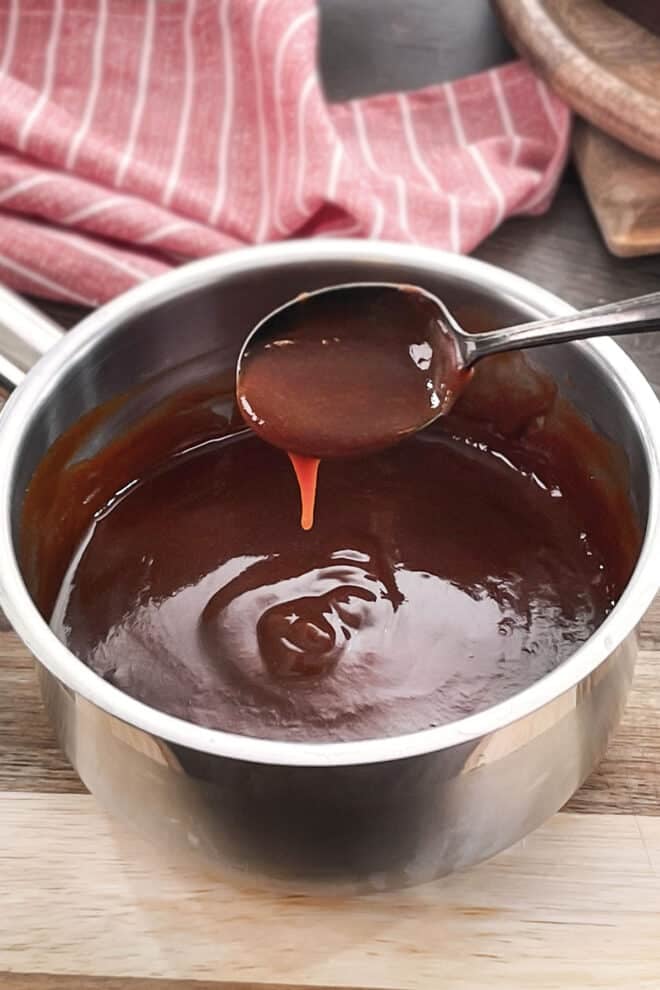
What Is Espagnole Sauce?
Espagnole sauce is one of the five classic French mother sauces. The others are velouté sauce, béchamel, hollandaise, and tomato sauce. Espagnole is similar to velouté except that it is made with dark stock like beef or veal, and a well-cooked roux. It also has more ingredients, like tomato paste and a mirepoix of carrots, celery, and onion.
While the sauce name means ‘Spanish’, the sauce actually comes from France. The origins are not completely agreed upon. A popular version of the story is that Spanish cooks working for French royalty added tomatoes to the French brown sauce. Regardless, it has been embraced by French chefs, including Auguste Escoffier, and so it is most definitely part of French cooking.
What Is Espagnole Sauce Used For?
Espagnole is often used as the starting point for demi-glace. To make a demi-glace, you combine equal parts of espagnole sauce and brown stock, reduce it by half, and then finish with some sherry wine. You can also use espagnole as the base of other sauces such as Bourguignonne and Chasseur Sauce.
This Espagnole Sauce recipe is also great to enjoy as written. Stir it into stews or soups or drizzle it over risotto. It’s great to go with steak, short ribs, or roasted lamb. The sauce also pairs nicely with mushroom dishes.
Ratios For Espagnole Sauce
First of all, since this recipe calls for stock or broth, I’ve purposely based it around 4 cups of stock, because that’s how much is in a 32 ounce container. I hate having a partially used carton of stock that gets shoved to the back of my fridge.
The sauce then uses a fairly basic ratio that we’ve seen in my gravy recipe, as well as béchamel and velouté sauces, of 1 tablespoon fat to 1 tablespoon flour to 1 cup of liquid. This sauce is reduced for longer than the others on our site though. It therefore ends up a bit thicker.
The final sauce in the below recipe ends up the thickness of a medium gravy but with a velvety texture from the butter.
The recipe below makes a sauce that can be used as is, and is especially good with meat and potatoes. However, a lot of versions of Sauce Espagnole are too strong-tasting to eat in that way. If you’re looking for that kind of extra-concentrated sauce, then you’ll reduce it even more than below, down to 1.5 to 2 cups. The version below is only reduced to 3 cups which is why it is delicious and balanced enough to eat on its own.
If you know that you want a thicker sauce, you can start with 6 tablespoons of butter and then use 6 tablespoons of flour. Everything else can stay the same. You can also or alternatively reduce the sauce more to make it thicker. If your sauce gets too thick because you’ve reduced it for too long, stir in some water or more stock to thin it back out.
How To Make Espagnole Sauce
Add the butter to a 3-quart sauce pan set over medium heat. Traditionally, clarified butter is used because without the milk solids, the sauce is less likely to darken too quickly and get bitter. Regular, unsalted butter can be used, just cook over a slightly lower heat and keep an eye that it so that it doesn’t darken too quickly.
Once the butter has melted, add the mirepoix (chopped onion, carrot, and celery). Cook and stir occasionally, until well-softened but not yet taking on any brown color, 4-5 minutes.
Sprinkle the flour over the veggies and stir to combine well so that the flour and butter form a paste, which is the roux for this sauce. Remember though that for espagnole sauce, the roux has to get nice and dark. So, you’ll continue to cook it, stirring and scraping frequently with a rubber spatula or flat whisk, until the roux is a bit darker than peanut butter, which will take about 5-6 minutes.
Next, stir in the tomato puree. If you don’t have puree, you can instead use a tablespoon of tomato paste mixed with a tablespoon of water. See more about this below.
Drizzle in about half a cup of the the beef stock and then stir well and be sure to scrape up all the browned bits stuck to the pan. Continue adding half of a cup more of the stock at a time, stirring after each addition to make sure it stays as smooth as possible. Add the peppercorns, bay leaf, parsley, and/or thyme, if using.
Bring the sauce to a simmer over medium-high heat. Then, reduce heat to maintain a low simmer, stirring occasionally until sauce is reduced to 3 cups. This will take about 35-45 minutes.
Remove sauce from heat. Set a fine mesh sieve over a bowl. Pour the sauce through the sieve and into the bowl. Discard contents of sieve. Taste the sauce and season to taste with salt.
Serve your espagnole sauce immediately or store in a sealed container in the fridge for up to 3 days. Many people put a layer of plastic wrap or wax paper directly onto the sauce before sealing the container. This is done to prevent a skin from forming on the sauce. I find that just stirring the sauce before heating it removes the skin though, so I skip this step.
Do You Have To Use Tomato Puree?
First, what is tomato puree? It’s cooked ripe tomatoes that are blended into a thick liquid. It makes a great basis for tomato sauces and other uses. It’s sold in cans but can also come in cartons similar to the cartons of broth.
Tomato puree is the traditional ingredient used for this sauce. But only a small amount of it is called for. I find it annoying to open a can just for that. If you don’t have another use for the puree, there are a couple of options. The most obvious is to use canned crushed tomatoes. They’re a bit thinner in flavor and texture, but they’ll do the trick. Using them means opening a new can though, so it doesn’t really solve the problem.
Using Tomato Paste Instead Of Puree
I would therefore recommend using tomato paste instead. It comes in smaller cans, so you’re not wasting as much. Even better, you can buy tomato paste in a tube that you keep in your fridge after opening it. This is my favorite! It costs a bit more than the cans, but you never have any waste, and it’s always there open and ready when you need it. To use tomato paste in this recipe, measure 1 tablespoon of it into a small bowl and then mix in 1 tablespoon of water.
Using Tomato Sauce Instead Of Puree
You can use a basic tomato sauce in place of the tomato puree as well. I often have a jar of tomato sauce in my fridge so dipping into there is pretty convenient. It’s best to use one that doesn’t have a lot of additional flavors and ingredients added. However, since only a small amount is used (2 tablespoons), and since you’ll be straining out any chunkier ingredients later anyhow, it doesn’t make that much of a difference.
Can You Use Tomato Ketchup Instead Of Puree?
Weirdly, yes. You can use 1 tablespoon of ketchup in place of the tomato puree. It won’t be detectable as ketchup in the finished sauce at all. But note that the sauce will have a slightly sweeter, slightly tangier final flavor than if tomato puree was used. And note that I actually LOVE making the Espagnole sauce with ketchup if I’m using it as a gravy for fries. It’s honestly probably the best fry gravy ever.
What About Fresh Tomatoes?
I’ve never tried it, but I’m guessing that if you chopped up a tomato and added it to the sauce prior to simmering, it would add the tomato flavor that we’re looking for. It won’t have as much depth and doesn’t have the thickness of the puree, but it will probably work. The great thing about sauces is that there are a lot of options, and this seems like a good one to try.
Tips For The Best Espagnole
During the first stage of cooking the vegetables, they shouldn’t get brown at all. If they do, they’re more likely to darken a lot and get bitter in the roux-cooking stage. It is better to err on the side of undercooking them than overcooking them. Since we’re not eating the vegetables anyhow, they’re just in there to add their flavor, it’s most important to keep their flavor good.
Similarly, during the roux-cooking stage, try to not let the vegetables darken too much. If they are getting dark before the roux is, you can turn the heat down.
As you’re cooking the roux, make sure to scrape the bottom of the pan often. I like to use a flat whisk for this since it stirs well and also can scrape. The crucial thing you’re trying to avoid is anything stuck to the bottom of the pan that is then more likely to burn and add bitterness to your sauce. So do this as you’re cooking the roux, and then also make sure that when you start adding your stock, everything is well scraped up from the bottom and sides of the pan.
If you do detect a bitter note in your finished sauce, likely due to over-darkened veggies or milk solids in the butter, be sure to add some salt in that last step. If you still detect bitterness, a pinch or two of sugar will help to counter it, and/or a touch more tomato puree or tomato paste.
You’ll notice that no salt is added to this sauce until the very end. This is because all stocks and broths are different in terms of their saltiness. Since you’ll be reducing the sauce by quite a bit, and thus concentrating any salt present in the stock, it’s best to not add it until all reducing is completed. You’ll therefore taste it at the end and add salt then.
Can you add other seasonings? Yes, and in fact, I think that some paprika and garlic powder makes it taste quite a bit like the famous Canadian Swiss Chalet sauce that was served with their rotisserie chickens and fries, especially if you use chicken stock instead of beef stock.
Espagnole Sauce Variations
- As mentioned above, using ketchup makes for an amazing fry gravy.
- Using chicken stock instead of beef makes a lovely sauce or gravy for chicken. It’s also an amazing base for a chicken or bean soup.
- 1 cup of red wine can be used in place of 1 cup of stock.
- 1 cup of the soaking liquid from dried mushrooms can be added in place of 1 cup of stock, then add sauteed mushrooms to the final sauce as well, if desired.
- 2 Tablespoons of heavy cream can be added at the very end, just to lighten the color and round everything out – this is amazing on mashed potatoes.
- Various herbs can be added during the simmering stage, depending on the intended use of the sauce. If it’s going on beef, add rosemary. If it’s going on chicken, some sage is lovely.
- For different flavor profiles, paprika or smoked paprika are always great.
- Garlic powder can be stirred in at the end, or minced garlic can be added when you add the tomato puree.
I hope you enjoy trying this classic French mother sauce. I’d love to hear what you think of it in the comments below, and be sure to tell me what variations you’ve tried and what you’ve served it with. I’m excited to hear all about it!
Podcast Episode: Making Espagnole Sauce
Listen to learn how to make this recipe, along with some great tips from Christine:
Listen to more Recipe of the Day episodes here.
Print
Espagnole Sauce Recipe
- Prep Time: 5 minutes
- Cook Time: 55 minutes
- Total Time: 1 hour
- Yield: 3 cups 1x
- Category: Sauce
- Method: Stovetop
- Cuisine: French
DESCRIPTION
With its rich dark color and gravy-like flavor, Espagnole Sauce is a delicious choice to serve with meat and potatoes. This French classic is also a great base for other sauces, soups, stews, and more.
Ingredients
- 1/4 cup (1/2 stick) clarified butter*
- 1 medium onion, chopped
- 1 medium carrot, peeled and chopped finely
- 1 rib celery, chopped finely
- 1/4 cup all-purpose flour
- 2 Tbsp. canned tomato puree**
- 4 cups beef stock***
- 1/4 tsp. whole black peppercorns (optional)
- 1 bay leaf (optional)
- 1/4 cup fresh parsley or parsley stems (optional)
- 1 sprig fresh thyme (optional)
- Salt
Instructions
- Add the butter to a 3-quart sauce pan set over medium heat. Once it melts, add the onion, carrot, and celery. Cook, stirring occasionally, until well-softened but not yet taking on any brown color, 4-5 minutes.
- Sprinkle vegetables with flour. Stir to combine well so that the flour and butter form a paste (this is the roux). Cook, stirring and scraping frequently with a rubber spatula or flat whisk, until the roux is a bit darker than peanut butter, about 5-6 minutes.
- Stir in the tomato puree. Drizzle in about half a cup of the the beef stock and then stir and scrape up any browned bits stuck to the pan. Then add a half of a cup more of the stock at a time, stirring after each addition to make sure it stays as smooth as possible.
- Add the peppercorns, bay leaf, parley, and/or thyme, if using.
- Bring to a simmer over medium-high heat. Reduce heat to maintain a low simmer, stirring occasionally until sauce is reduced to 3 cups, about 35-45 minutes.
- Remove sauce from heat. Set a fine mesh sieve over a bowl. Pour the sauce through the sieve and into the bowl. Discard contents of sieve.
- Taste the sauce and season to taste with salt. Serve immediately or store in a sealed container in the fridge for up to 3 days.
Love this recipe? I’d appreciate it if you could scroll down and add a *5 star rating* to help others know they’ll love it as well!
Notes
*Clarified butter is traditionally used here because its milk solids have been removed, making it less likely to darken too quickly and get bitter. However, since we actually want a dark sauce in this case, normal unsalted butter will be fine. Just watch it to make sure that it doesn’t get dark too fast. If you’re not using clarified butter, you will need to turn the heat down a little. Let the veggies, and then the roux cook slowly, reducing the heat if anything starts to brown more quickly than expected.
**Instead of canned tomato puree, mix together 1 tablespoon of tomato paste with 1 tablespoon of water. Two tablespoons of tomato (marinara) sauce can also be used as a substitute. Alternatively, you can use ketchup, but then only use 1 tablespoon total.
***Veal demi-glace concentrate is wonderful to use here. Find it at a specialty store or online. Reconstitute it according to package instructions before using. You’ll want 4 cups once it is correctly diluted. You can also use beef bouillon mixed with water according to package instructions (but let resulting broth cool a bit before using).
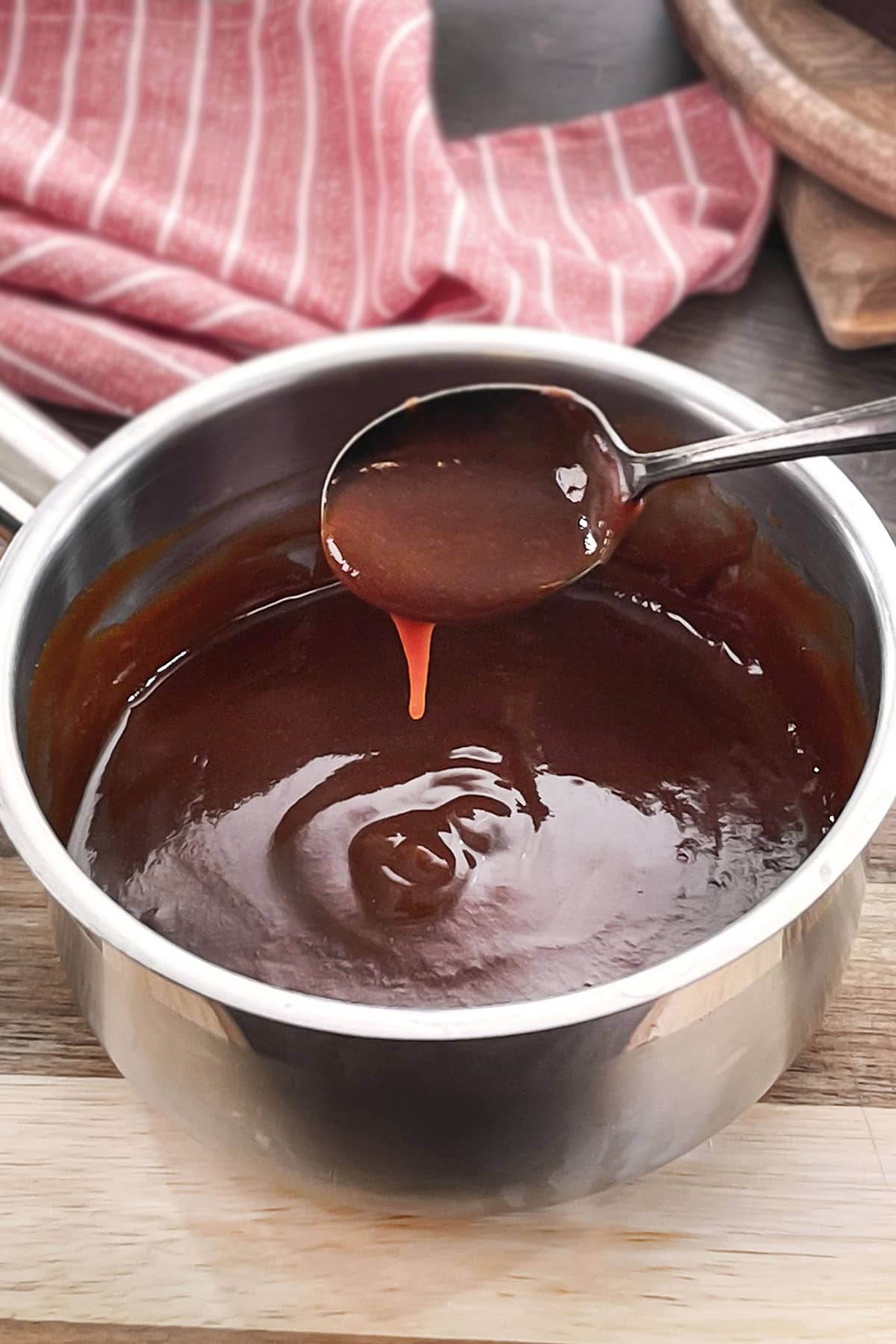

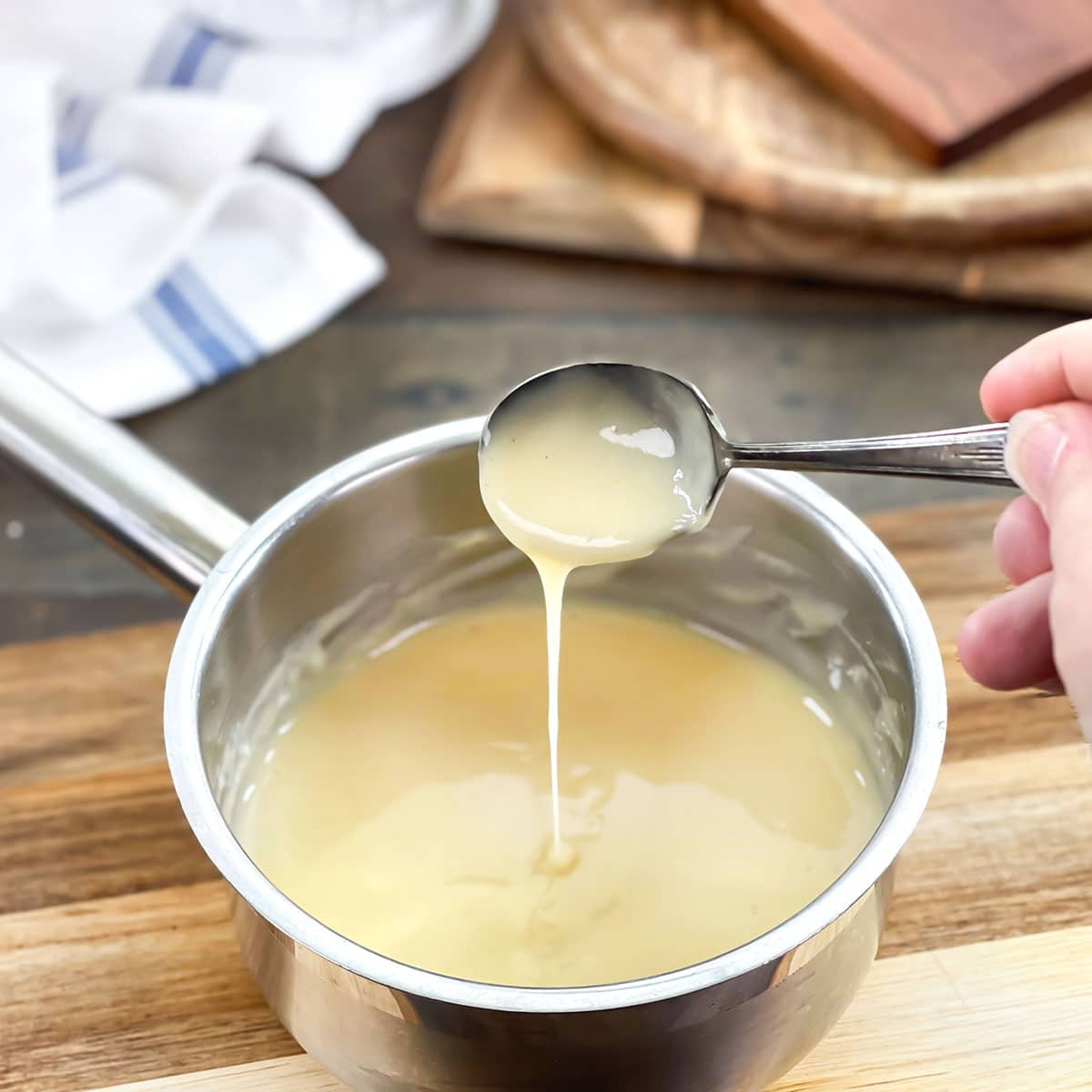
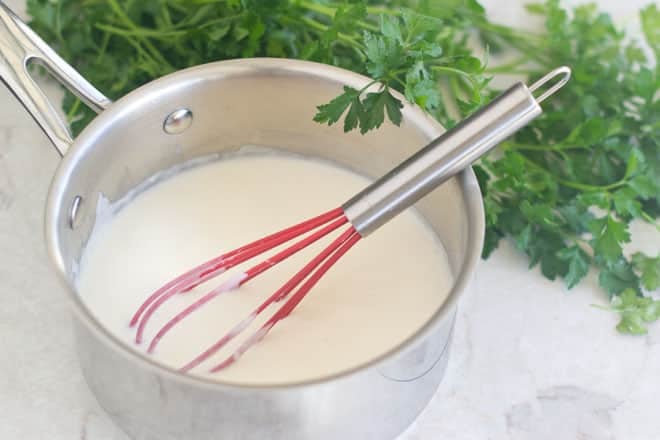
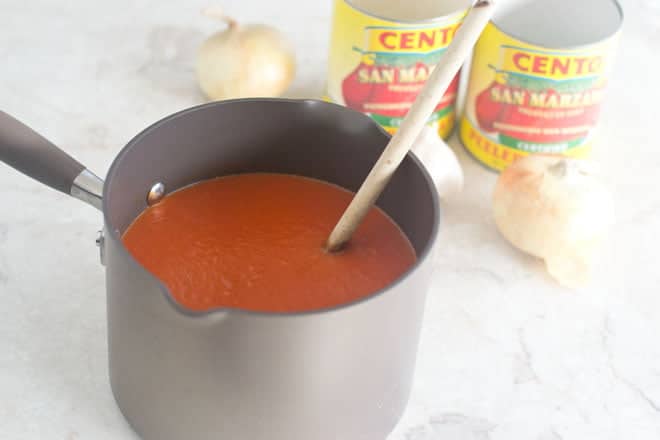
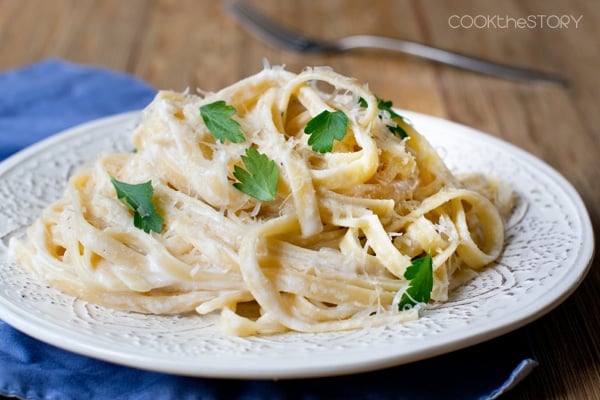



















Leave a Reply